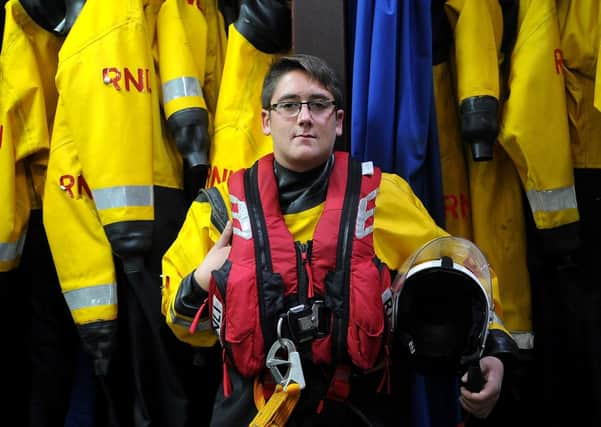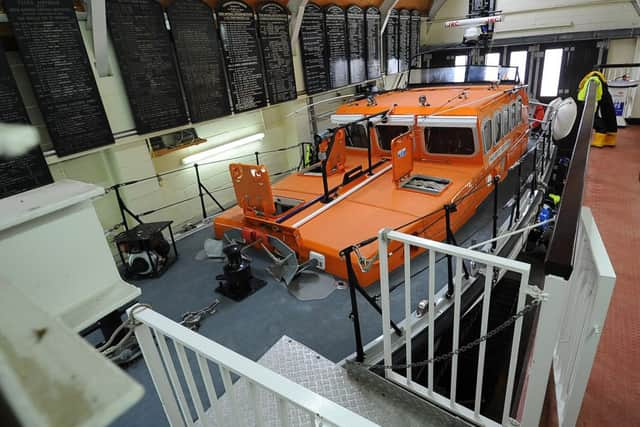Tide set to turn for lifeboatmen


ON A lovely, clear early autumn day, there are still plenty of visitors milling around the seafront.
At low tide, they are venturing onto the rocky outcrop of Filey Brigg, poking around the rockpools below the cliffs, and going gingerly across the patches of slippery green weed. There is a school party from South Yorkshire tucking into packed lunches on a grassy bank, the children itching to explore the rocks before the afternoon is out.
Advertisement
Hide AdAdvertisement
Hide AdThe crew room at Filey Lifeboat Station overlooks the Coble Landing, and beyond it, the Brigg. The men and women who gather there for briefings before exercises know the rocks better than any of the visitors, because it’s one of their most regular destinations aboard the inshore lifeboat.


There are people with fractured wrists and ankles from slipping on the seaweed to be brought back to shore, and those who linger too long, only to be cut off by the tide that sweeps in with alarming speed. There’s been a three-legged dog that tumbled off the cliffs to be saved, and another dog that did likewise, also ending up with three legs as a result.
On a day like this, when the sea is calm and the wind light, it’s hard for the visitors going in search of shrimps and tiny crabs amongst the rocks to comprehend just how ferocious these waters can be.
The crew knows, though. Earlier this year, on exercise, Filey’s all-weather lifeboat, Keep Fit Association, took such a battering that the windscreen wipers were bent out of shape and even those aboard who have been at sea for decades were sick.
Advertisement
Hide AdAdvertisement
Hide AdShe brought them back safe, of course, as she has for more than two decades. But soon, Filey will be bidding her farewell. The RNLI has decided that by 2017, after 26 years, she will be replaced by a new, faster inshore lifeboat. New all-weather boats will be stationed at Scarborough and Bridlington before Keep Fit Association is withdrawn, and they, rather than Filey, will handle rescues farther out to sea.
There’s a touch of sadness in Filey about the decision, an undercurrent that the station has been downgraded after a long and brave history that stretches back to 1804 and the town’s first lifeboat.
They’ll make the best of it, though, their devotion to doing what they love and to the RNLI seeing to that. For Barry Robson, 51, the coxswain and full-time mechanic at the station, the change means uncertainty over his future with the lifeboat. He’s certain about one thing, though: he’ll still be down here, in whatever capacity he can help, whether it be washing her down or driving the tractor used for launches.
Most of his life has been bound up with the Filey lifeboat, even though he never expected it to turn out that way. At 16, he would help to launch it, and for the past 25 years, he’s been part of the crew, serving as mechanic for the last 15.
Advertisement
Hide AdAdvertisement
Hide Ad“I never set out to be a lifeboatman,” he said. “I’m a plumber by trade, and then I worked on the oil rigs and I was a fisherman out of Filey and they were looking for more crew. There were two or three of my mates on the boat, so I joined and worked my way up through the system.
“A lot of the crew are mates of mates, which is how a lot of people join. We work for each other, when I’m at sea I rely on the other six people to get the job done. You don’t have the same crew every time you go, and what we try and instil when they join is we work together for the outcome we want.”
Barry has an insight into what it means to be rescued by lifeboat, having needed its help several times.
“I’ve been towed in when I was fishing two or three times, the crew just take the mickey. I’ve got an angling boat, and they’re dying for me to break down so they can come and tow me back and slap my picture all over Facebook. The thing is, you never know who you’re going for – they might have been round the world three times, for all we know it could be a master mariner and this might just be his unlucky day.
Advertisement
Hide AdAdvertisement
Hide Ad“I know I was glad to see the lifeboat coming, it was a horrible day, and you see the orange and blue boat coming over the horizon, and it’s, ‘Yeah’, you feel loads safer.”
He’s known much grimmer days than that, though, like the aftermath of an RAF Tornado warplane crashing into the sea in 2002, when the boat returned home carrying body parts as well as wreckage.
At least there was something to recover. “You always want to find something. It’s when you don’t find something, that’s the worst bit. We searched 16 hours for a boat, and we never found anything, and you feel like you’ve failed. You haven’t, you’ve done what you can, but you wish that you’d found something.”
At the opposite end of the spectrum to Barry’s vast experience is the station’s youngest person, 17-year-old probationary crewman Callum Garton, who is studying health and social care at college before hoping to go to university. “I want to be a paramedic, and I want to save lives, but you can’t just join the NHS and do that, and this was the closest thing to start me off.”
Advertisement
Hide AdAdvertisement
Hide AdHe’s on a journey already taken by the next youngest, Sam Cross, 22, who also joined when he was 17. “I was living a stone’s throw away on the clifftop, and looking down to see everyone going out and I wanted to be part of that, and did the pleading, ‘Let me join, let me join’.”
They did. Sam is one of a group of merchant seamen amongst the crew, which also includes teachers, plumbers, joiners and petrochemical workers.
There’s also an ex-Royal Navy man at the station, lifeboat operations manager John Colling, who is the first point of contact for the coastguard. His 30 years at sea, including air operations, are a bonus when it comes to co-ordinating the lifeboat and air sea rescue. “My naval experience is a huge help, especially the aviation experience”, he said. “I understand what the helicopters are talking about.”
The crew are backed up by an enthusiastic team of volunteer helpers, more than 30 of them involved with the shop attached to the station, which is vital to the fundraising effort. It’s tiny, little more than a cubbyhole, but judged by every pound taken per square foot of space, it’s the most successful anywhere in the RNLI.
Advertisement
Hide AdAdvertisement
Hide AdA fixture behind the counter is Chris Clubley, 58, who has been involved for about 40 years and is still helping to launch the lifeboat. In between, he puts in long hours at the shop – seven days a week in summer, from 10am until 9pm. He’s there throughout the winter as well, but at weekends only.
It’s a measure of how close Filey holds its lifeboat to its heart that the crew is regularly asked to scatter ashes at sea. They have a dignified ritual; the boat comes close in ashore, so that relatives can watch as a chaplain reads the Lifeboat Prayer, there are three blasts on the siren and then the ashes are scattered.
The next few years will see change at Filey Lifeboat Station, but its people and the community they serve will undoubtedly remain devoted to each other. Barry said: “I was born here, and I’ll die here. I’ve no inclination to go anywhere else. I love Filey, and that’s it.”
Next week: Bridlington.